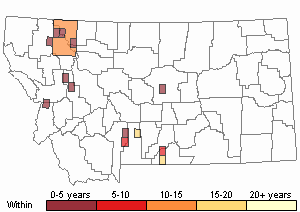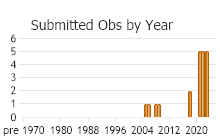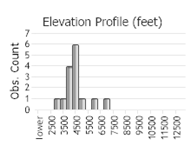View in other NatureServe Network Field Guides
NatureServe
Montana
Utah
Wyoming
Idaho
Wisconsin
British Columbia
South Carolina
Yukon
California
New York
Langton's Forester Moth - Alypia langtoni
General Description
Langton's Forester (
Alypia langtoni) is the only explicitly sexually dimorphic species of
Alypia. The male and female forewings are both black with two yellow-white patches. The yellow-white patches are slightly larger and more irregular in the female than the male. The male hindwing is black with a white basal region separated by a black bridge running through the discal area from a small, round other white patch. The basal white patch is streaked with black on the cubital and anal veins but most strongly on the anal vein. The size of the white patches in the male hindwing is variable and in some individuals the patches can be very small. The ventral hindwing pattern recapitulates the dorsal surface. The female hindwing is black with a single yellow patch in the distal part of the discal cell, although some rare specimens (particularly from California) have a small basal yellow patch as well. The wingspan is about 30 mm (Poole 1994).
The larvae ground color is white with extensive black-brown markings. The setae are well developed and the pinaculae are large and black-brown. A large black-brown patch is present in the dorsal region of each abdominal segment. This large patch includes the pairs of setae D1 and D2. The black of this large patch runs downward into the region of the spiracle on either side of the abdomen. This large dorsal patch is followed on the caudal half of each segment by a much smaller triangular patch. This small triangular patch usually has a small yellow-white central area. The spiracle of each abdominal segment is surrounded by an irregular orange patch. This patch is enclosed on both sides by irregular black-brown lines running down from the large black-brown patch on the dorsal surface of each segment. Irregular black-brown patches and lines are found both caudal and cephalad to the central region of the segment. A series of yellow-white patches forms an irregular subspiracular line. A large white patch stretches from seta L1 on abdominal segment 7 to L2 on abdominal segment 8 (Poole 1994).
Phenology
Langton's Forester flies in June and July throughout most of the range of the species, although occurring as early as May in the more southerly parts of the species range (California and Arizona). Adults are diurnal, visiting flowers (Poole 1994).
Diagnostic Characteristics
The female Langton's Forester is easily separated from that of the female Eight-spotted Forester (
A. octomaculata) by the presence of a single yellow-white patch in the hindwing. However, the male is very similar to that of the male Eight-spotted Forester and is easy to misidentify in localities both species are likely to inhabit. The best character separating males of the two species is the presence of white rings around each of the basal antennal segments in the Langton's Forester and their absence in the Eight-spotted Forester (Poole 1994).
A smaller pyralid moth (Anania funebris) is superficially very similar, down to the yellow tegulae, but is much smaller (18-22 mm wingspan) and less robust (Anweiler 2008).
The larvae of the Langton's Forester larvae might be confused with either the Eight-spotted Forester or A. maccullochii. However, the foodplants of the Langton's Forester and the Eight-spotted Forester appear to be mutually exclusive. The abdominal segments of the Eight-spotted Forester are primarily white, with thin, distinct vertical (dorsal to ventral) black lines. The black-brown lines of the Langton's Forester are much more irregular and not distinctly vertical. The dorsal surface of the Eight-spotted Forester is primarily white and crossed by the thin black-brown lines found on the lateral sides of the segments. The dorsal surface of the Langton's Forester has two large black-brown patches. Both A. langtoni and A. maccullochii feed on Epilobium spp. and both species occur in approximately the same parts of North America. The best character separating the two species is the presence of a large, white patch stretching between seta L1 on abdominal segment 7 and seta L2 on abdominal segment 8. This distinct white patch is absent in A. maccullochii (Poole 1994).
Range Comments
Langton's Forester has a wide distribution in northern North America. The species occurs throughout most of Canada from the Canadian Zone forests of southern Canada to the boreal forest and tundra regions of the Northwest Territories, the Yukon, and Alaska. It occurs in the eastern United States in northern and central Maine, northern New Hampshire, northern Vermont, and the Adirondack Mountains of upstate New York. This species has a wide distribution in the mountains of the western United States. The moth has been collected from the Canadian border east to western Montana and western South Dakota and south as far as the White Mountains of central Arizona (Poole 1994).
Observations in Montana Natural Heritage Program Database
Number of Observations: 28
(Click on the following maps and charts to see full sized version)
Map Help and Descriptions
Relative Density

Recency



 (Observations spanning multiple months or years are excluded from time charts)
(Observations spanning multiple months or years are excluded from time charts)
Habitat
Langton's Forester is widespread in the province of Alberta, and found throughout the wooded areas except in the grasslands (Anweiler 2008).
Food Habits
The larva feed on the foliage of
Epilobium (fireweed) (Anweiler 2008).
Stewardship Responsibility
References
- Literature Cited AboveLegend:
 View Online Publication
View Online Publication Poole, R.W. 1994. Noctuoidea, Noctuidae: Fascicle 26.1: Cuculliniinae, Stiriinae, Psaphidinae (Part). The Moths of America North of Mexico (Lepidoptera). E. W. Classey Ltd. and R.B.D. Publications, London, England. 250 pp.
Poole, R.W. 1994. Noctuoidea, Noctuidae: Fascicle 26.1: Cuculliniinae, Stiriinae, Psaphidinae (Part). The Moths of America North of Mexico (Lepidoptera). E. W. Classey Ltd. and R.B.D. Publications, London, England. 250 pp.
- Web Search Engines for Articles on "Langton's Forester Moth"
- Additional Sources of Information Related to "Insects"





